Renal Failure: Pathophysiology, Clinical Features, and Treatment
VerifiedAdded on 2022/08/22
|9
|2423
|18
Report
AI Summary
This report provides a detailed overview of renal failure, a condition where the kidneys fail to remove waste from the body. It begins by defining the urinary system and its functions, then delves into the pathophysiology of renal failure, exploring its various causes, including acute and chronic forms. The report examines age, race, and sex predilections, as well as the locations within the kidney where the disease manifests. It outlines the clinical features and symptoms of renal failure, such as reduced urine output, swelling, shortness of breath, and potential complications. The report further discusses treatment options, including blood tests, dialysis, and kidney transplantation, along with dietary and pharmacological interventions. Finally, it highlights considerations for dental hygiene in patients with renal failure, emphasizing the importance of oral health in managing the disease. This report aims to provide a comprehensive understanding of renal failure and its management.
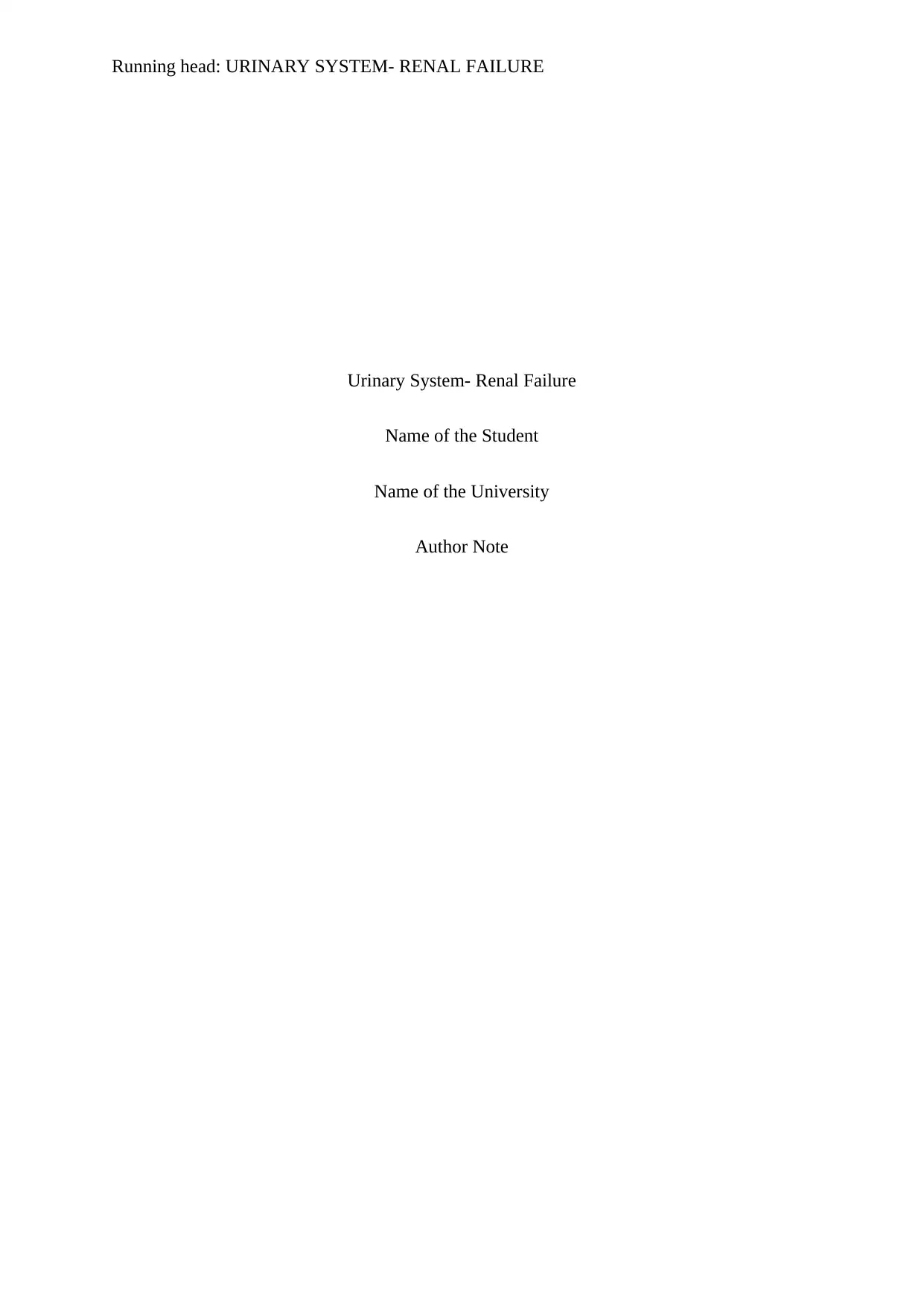
Running head: URINARY SYSTEM- RENAL FAILURE
Urinary System- Renal Failure
Name of the Student
Name of the University
Author Note
Urinary System- Renal Failure
Name of the Student
Name of the University
Author Note
Paraphrase This Document
Need a fresh take? Get an instant paraphrase of this document with our AI Paraphraser
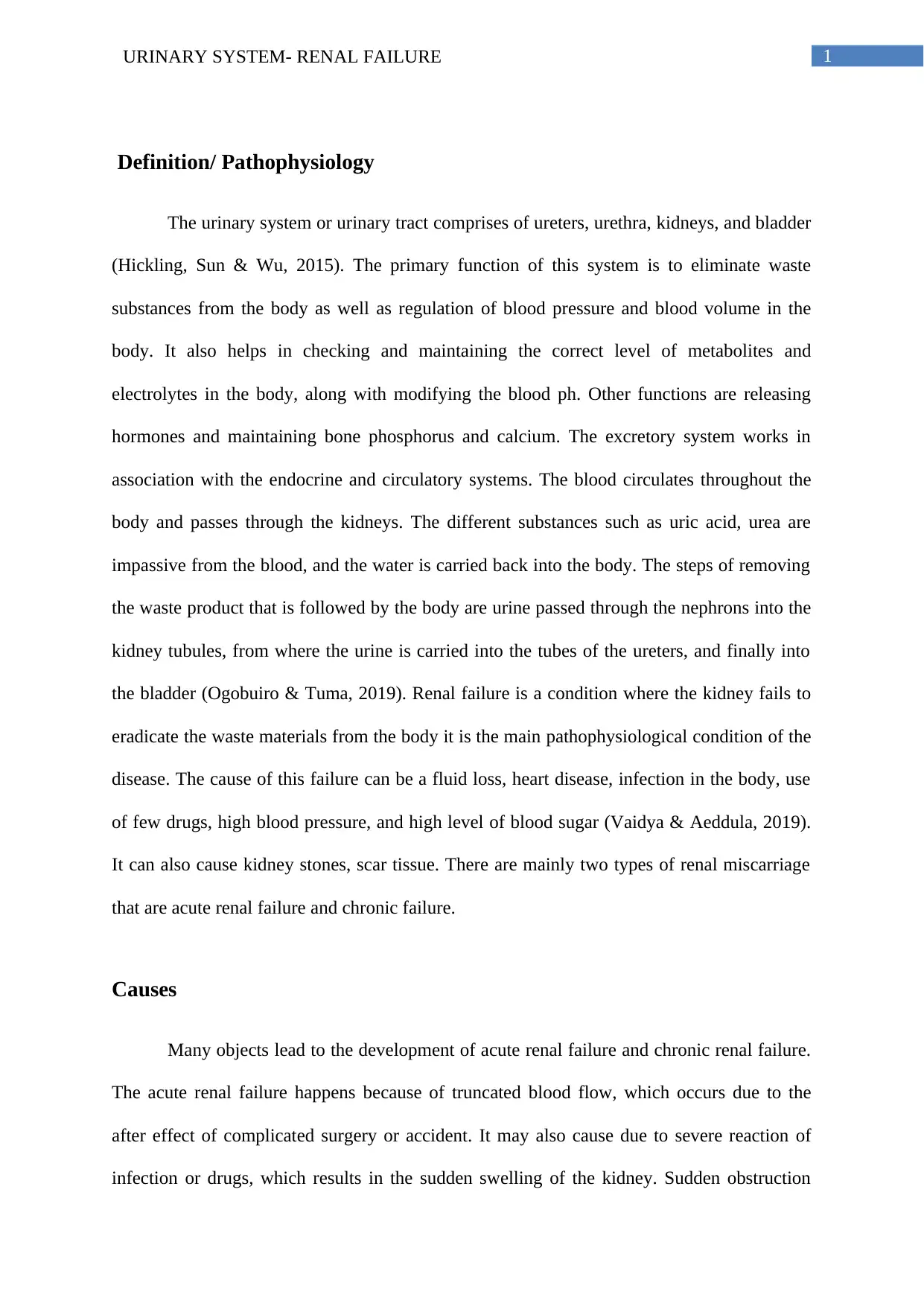
1URINARY SYSTEM- RENAL FAILURE
Definition/ Pathophysiology
The urinary system or urinary tract comprises of ureters, urethra, kidneys, and bladder
(Hickling, Sun & Wu, 2015). The primary function of this system is to eliminate waste
substances from the body as well as regulation of blood pressure and blood volume in the
body. It also helps in checking and maintaining the correct level of metabolites and
electrolytes in the body, along with modifying the blood ph. Other functions are releasing
hormones and maintaining bone phosphorus and calcium. The excretory system works in
association with the endocrine and circulatory systems. The blood circulates throughout the
body and passes through the kidneys. The different substances such as uric acid, urea are
impassive from the blood, and the water is carried back into the body. The steps of removing
the waste product that is followed by the body are urine passed through the nephrons into the
kidney tubules, from where the urine is carried into the tubes of the ureters, and finally into
the bladder (Ogobuiro & Tuma, 2019). Renal failure is a condition where the kidney fails to
eradicate the waste materials from the body it is the main pathophysiological condition of the
disease. The cause of this failure can be a fluid loss, heart disease, infection in the body, use
of few drugs, high blood pressure, and high level of blood sugar (Vaidya & Aeddula, 2019).
It can also cause kidney stones, scar tissue. There are mainly two types of renal miscarriage
that are acute renal failure and chronic failure.
Causes
Many objects lead to the development of acute renal failure and chronic renal failure.
The acute renal failure happens because of truncated blood flow, which occurs due to the
after effect of complicated surgery or accident. It may also cause due to severe reaction of
infection or drugs, which results in the sudden swelling of the kidney. Sudden obstruction
Definition/ Pathophysiology
The urinary system or urinary tract comprises of ureters, urethra, kidneys, and bladder
(Hickling, Sun & Wu, 2015). The primary function of this system is to eliminate waste
substances from the body as well as regulation of blood pressure and blood volume in the
body. It also helps in checking and maintaining the correct level of metabolites and
electrolytes in the body, along with modifying the blood ph. Other functions are releasing
hormones and maintaining bone phosphorus and calcium. The excretory system works in
association with the endocrine and circulatory systems. The blood circulates throughout the
body and passes through the kidneys. The different substances such as uric acid, urea are
impassive from the blood, and the water is carried back into the body. The steps of removing
the waste product that is followed by the body are urine passed through the nephrons into the
kidney tubules, from where the urine is carried into the tubes of the ureters, and finally into
the bladder (Ogobuiro & Tuma, 2019). Renal failure is a condition where the kidney fails to
eradicate the waste materials from the body it is the main pathophysiological condition of the
disease. The cause of this failure can be a fluid loss, heart disease, infection in the body, use
of few drugs, high blood pressure, and high level of blood sugar (Vaidya & Aeddula, 2019).
It can also cause kidney stones, scar tissue. There are mainly two types of renal miscarriage
that are acute renal failure and chronic failure.
Causes
Many objects lead to the development of acute renal failure and chronic renal failure.
The acute renal failure happens because of truncated blood flow, which occurs due to the
after effect of complicated surgery or accident. It may also cause due to severe reaction of
infection or drugs, which results in the sudden swelling of the kidney. Sudden obstruction
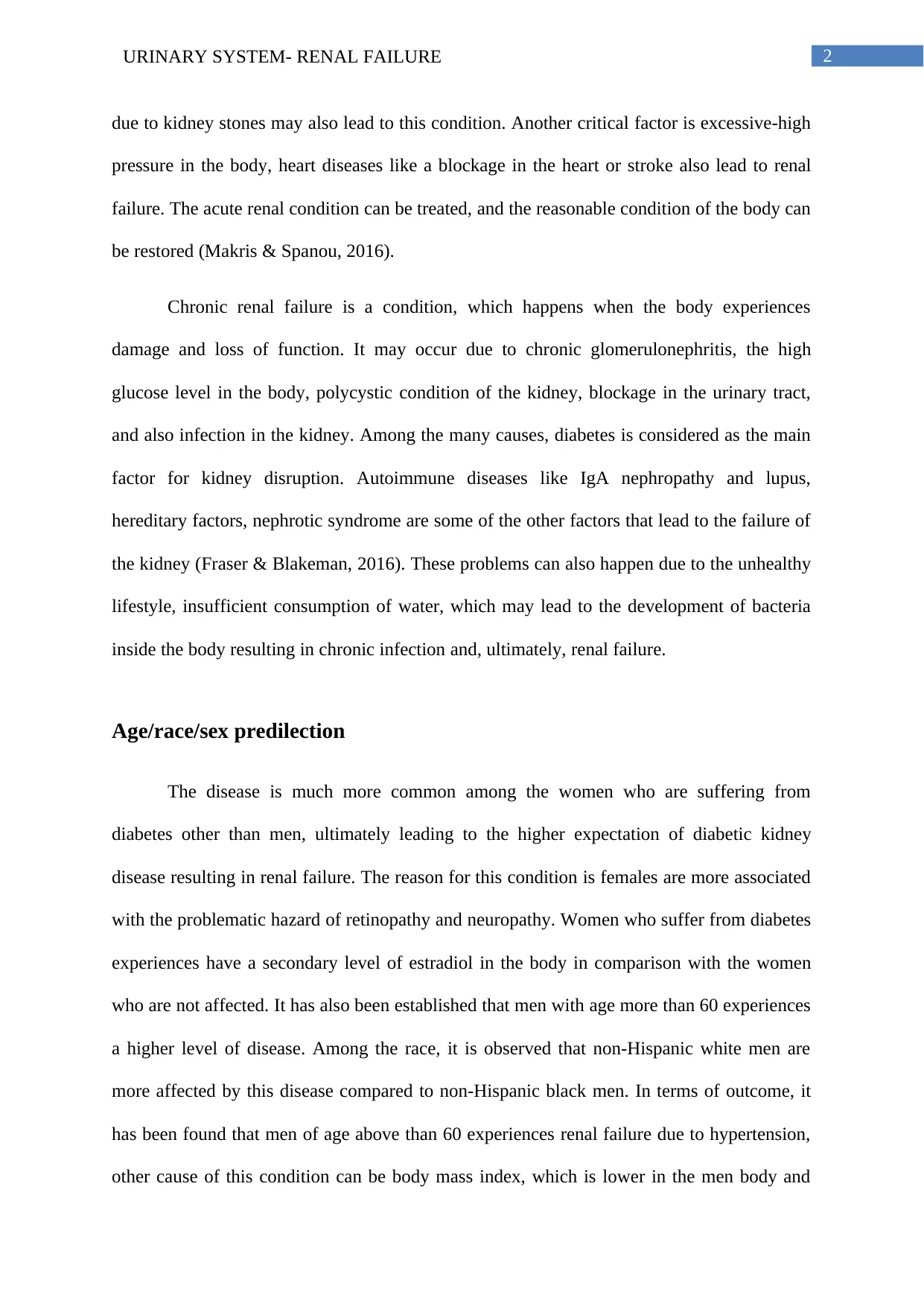
2URINARY SYSTEM- RENAL FAILURE
due to kidney stones may also lead to this condition. Another critical factor is excessive-high
pressure in the body, heart diseases like a blockage in the heart or stroke also lead to renal
failure. The acute renal condition can be treated, and the reasonable condition of the body can
be restored (Makris & Spanou, 2016).
Chronic renal failure is a condition, which happens when the body experiences
damage and loss of function. It may occur due to chronic glomerulonephritis, the high
glucose level in the body, polycystic condition of the kidney, blockage in the urinary tract,
and also infection in the kidney. Among the many causes, diabetes is considered as the main
factor for kidney disruption. Autoimmune diseases like IgA nephropathy and lupus,
hereditary factors, nephrotic syndrome are some of the other factors that lead to the failure of
the kidney (Fraser & Blakeman, 2016). These problems can also happen due to the unhealthy
lifestyle, insufficient consumption of water, which may lead to the development of bacteria
inside the body resulting in chronic infection and, ultimately, renal failure.
Age/race/sex predilection
The disease is much more common among the women who are suffering from
diabetes other than men, ultimately leading to the higher expectation of diabetic kidney
disease resulting in renal failure. The reason for this condition is females are more associated
with the problematic hazard of retinopathy and neuropathy. Women who suffer from diabetes
experiences have a secondary level of estradiol in the body in comparison with the women
who are not affected. It has also been established that men with age more than 60 experiences
a higher level of disease. Among the race, it is observed that non-Hispanic white men are
more affected by this disease compared to non-Hispanic black men. In terms of outcome, it
has been found that men of age above than 60 experiences renal failure due to hypertension,
other cause of this condition can be body mass index, which is lower in the men body and
due to kidney stones may also lead to this condition. Another critical factor is excessive-high
pressure in the body, heart diseases like a blockage in the heart or stroke also lead to renal
failure. The acute renal condition can be treated, and the reasonable condition of the body can
be restored (Makris & Spanou, 2016).
Chronic renal failure is a condition, which happens when the body experiences
damage and loss of function. It may occur due to chronic glomerulonephritis, the high
glucose level in the body, polycystic condition of the kidney, blockage in the urinary tract,
and also infection in the kidney. Among the many causes, diabetes is considered as the main
factor for kidney disruption. Autoimmune diseases like IgA nephropathy and lupus,
hereditary factors, nephrotic syndrome are some of the other factors that lead to the failure of
the kidney (Fraser & Blakeman, 2016). These problems can also happen due to the unhealthy
lifestyle, insufficient consumption of water, which may lead to the development of bacteria
inside the body resulting in chronic infection and, ultimately, renal failure.
Age/race/sex predilection
The disease is much more common among the women who are suffering from
diabetes other than men, ultimately leading to the higher expectation of diabetic kidney
disease resulting in renal failure. The reason for this condition is females are more associated
with the problematic hazard of retinopathy and neuropathy. Women who suffer from diabetes
experiences have a secondary level of estradiol in the body in comparison with the women
who are not affected. It has also been established that men with age more than 60 experiences
a higher level of disease. Among the race, it is observed that non-Hispanic white men are
more affected by this disease compared to non-Hispanic black men. In terms of outcome, it
has been found that men of age above than 60 experiences renal failure due to hypertension,
other cause of this condition can be body mass index, which is lower in the men body and
⊘ This is a preview!⊘
Do you want full access?
Subscribe today to unlock all pages.

Trusted by 1+ million students worldwide
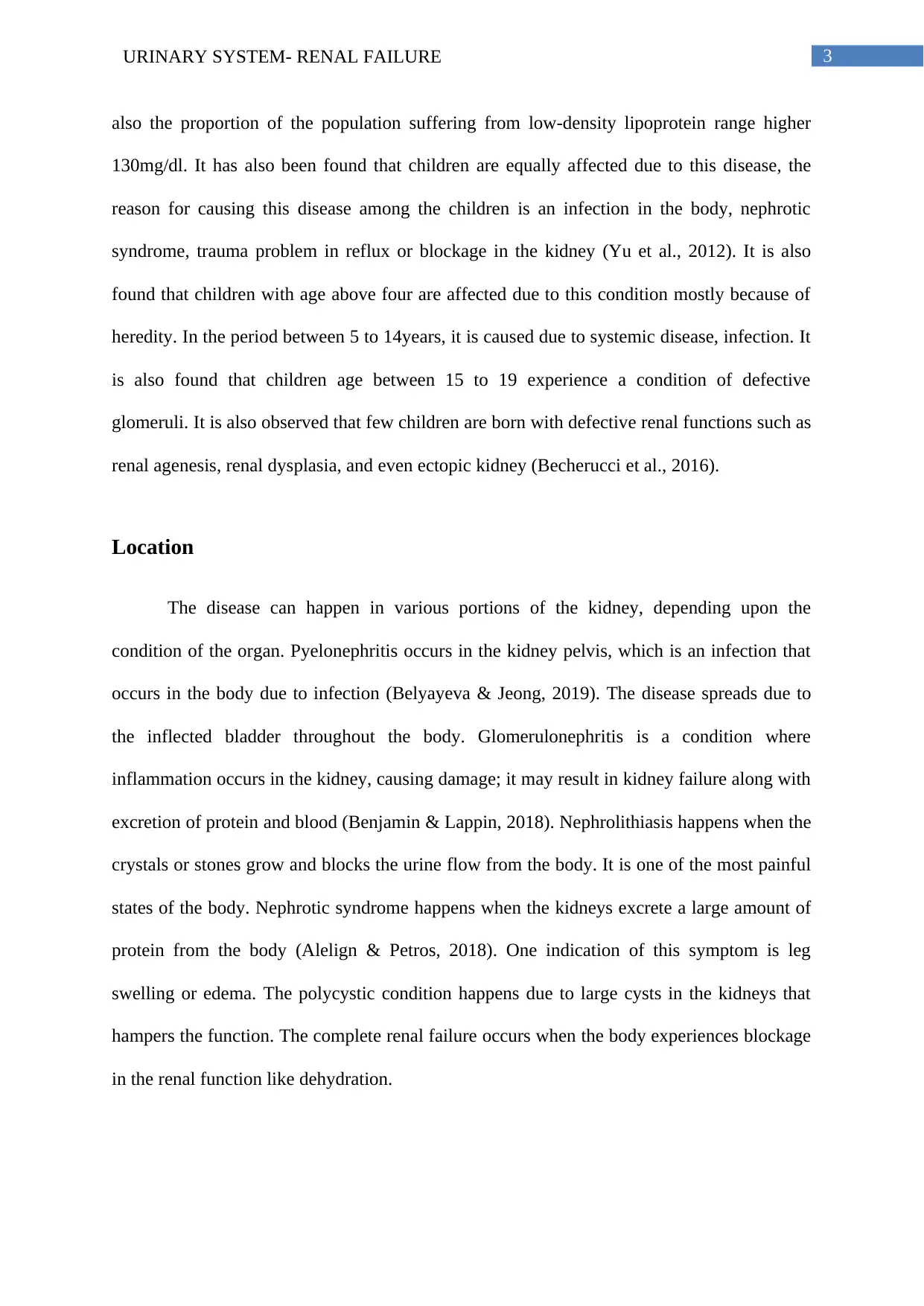
3URINARY SYSTEM- RENAL FAILURE
also the proportion of the population suffering from low-density lipoprotein range higher
130mg/dl. It has also been found that children are equally affected due to this disease, the
reason for causing this disease among the children is an infection in the body, nephrotic
syndrome, trauma problem in reflux or blockage in the kidney (Yu et al., 2012). It is also
found that children with age above four are affected due to this condition mostly because of
heredity. In the period between 5 to 14years, it is caused due to systemic disease, infection. It
is also found that children age between 15 to 19 experience a condition of defective
glomeruli. It is also observed that few children are born with defective renal functions such as
renal agenesis, renal dysplasia, and even ectopic kidney (Becherucci et al., 2016).
Location
The disease can happen in various portions of the kidney, depending upon the
condition of the organ. Pyelonephritis occurs in the kidney pelvis, which is an infection that
occurs in the body due to infection (Belyayeva & Jeong, 2019). The disease spreads due to
the inflected bladder throughout the body. Glomerulonephritis is a condition where
inflammation occurs in the kidney, causing damage; it may result in kidney failure along with
excretion of protein and blood (Benjamin & Lappin, 2018). Nephrolithiasis happens when the
crystals or stones grow and blocks the urine flow from the body. It is one of the most painful
states of the body. Nephrotic syndrome happens when the kidneys excrete a large amount of
protein from the body (Alelign & Petros, 2018). One indication of this symptom is leg
swelling or edema. The polycystic condition happens due to large cysts in the kidneys that
hampers the function. The complete renal failure occurs when the body experiences blockage
in the renal function like dehydration.
also the proportion of the population suffering from low-density lipoprotein range higher
130mg/dl. It has also been found that children are equally affected due to this disease, the
reason for causing this disease among the children is an infection in the body, nephrotic
syndrome, trauma problem in reflux or blockage in the kidney (Yu et al., 2012). It is also
found that children with age above four are affected due to this condition mostly because of
heredity. In the period between 5 to 14years, it is caused due to systemic disease, infection. It
is also found that children age between 15 to 19 experience a condition of defective
glomeruli. It is also observed that few children are born with defective renal functions such as
renal agenesis, renal dysplasia, and even ectopic kidney (Becherucci et al., 2016).
Location
The disease can happen in various portions of the kidney, depending upon the
condition of the organ. Pyelonephritis occurs in the kidney pelvis, which is an infection that
occurs in the body due to infection (Belyayeva & Jeong, 2019). The disease spreads due to
the inflected bladder throughout the body. Glomerulonephritis is a condition where
inflammation occurs in the kidney, causing damage; it may result in kidney failure along with
excretion of protein and blood (Benjamin & Lappin, 2018). Nephrolithiasis happens when the
crystals or stones grow and blocks the urine flow from the body. It is one of the most painful
states of the body. Nephrotic syndrome happens when the kidneys excrete a large amount of
protein from the body (Alelign & Petros, 2018). One indication of this symptom is leg
swelling or edema. The polycystic condition happens due to large cysts in the kidneys that
hampers the function. The complete renal failure occurs when the body experiences blockage
in the renal function like dehydration.
Paraphrase This Document
Need a fresh take? Get an instant paraphrase of this document with our AI Paraphraser
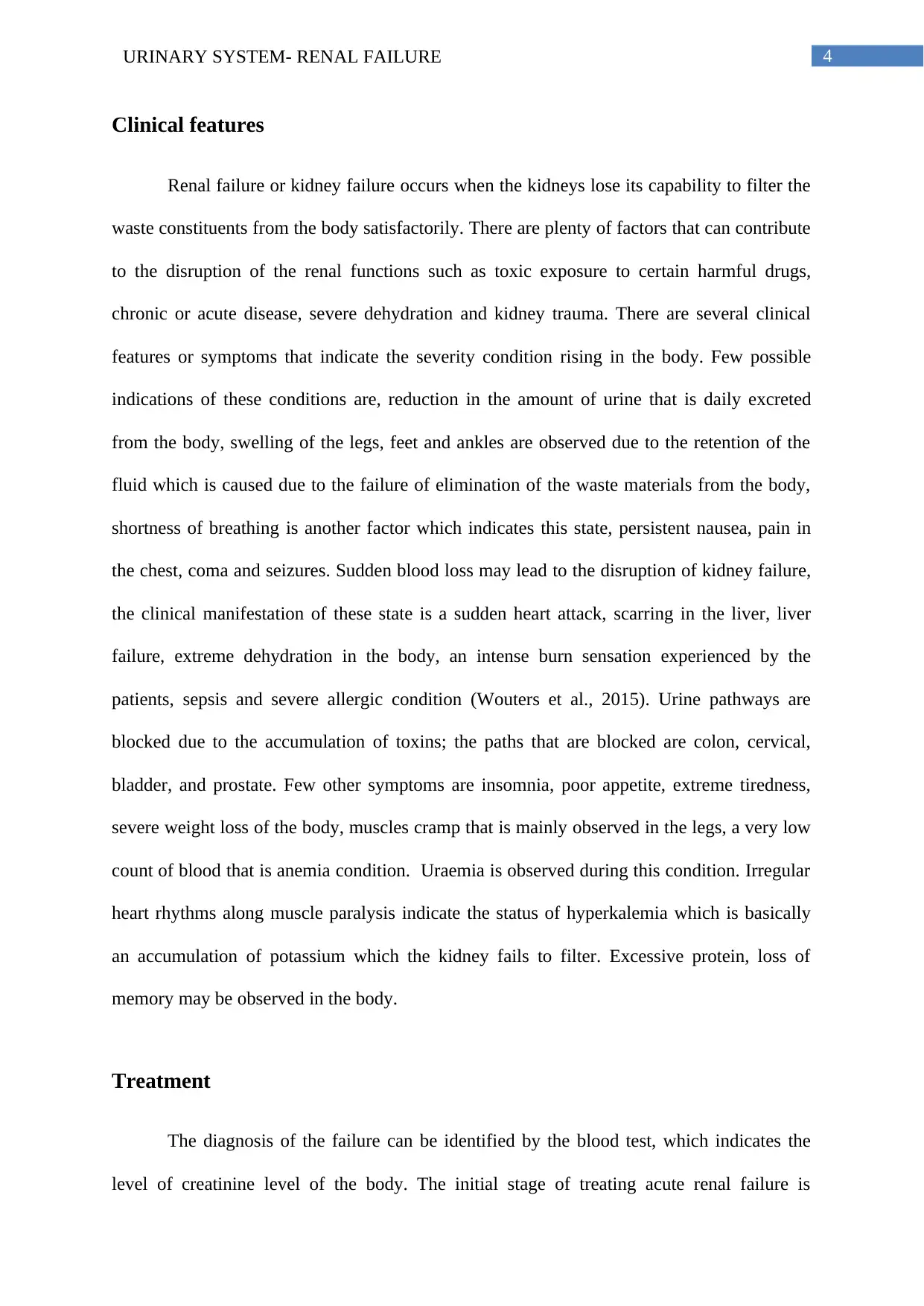
4URINARY SYSTEM- RENAL FAILURE
Clinical features
Renal failure or kidney failure occurs when the kidneys lose its capability to filter the
waste constituents from the body satisfactorily. There are plenty of factors that can contribute
to the disruption of the renal functions such as toxic exposure to certain harmful drugs,
chronic or acute disease, severe dehydration and kidney trauma. There are several clinical
features or symptoms that indicate the severity condition rising in the body. Few possible
indications of these conditions are, reduction in the amount of urine that is daily excreted
from the body, swelling of the legs, feet and ankles are observed due to the retention of the
fluid which is caused due to the failure of elimination of the waste materials from the body,
shortness of breathing is another factor which indicates this state, persistent nausea, pain in
the chest, coma and seizures. Sudden blood loss may lead to the disruption of kidney failure,
the clinical manifestation of these state is a sudden heart attack, scarring in the liver, liver
failure, extreme dehydration in the body, an intense burn sensation experienced by the
patients, sepsis and severe allergic condition (Wouters et al., 2015). Urine pathways are
blocked due to the accumulation of toxins; the paths that are blocked are colon, cervical,
bladder, and prostate. Few other symptoms are insomnia, poor appetite, extreme tiredness,
severe weight loss of the body, muscles cramp that is mainly observed in the legs, a very low
count of blood that is anemia condition. Uraemia is observed during this condition. Irregular
heart rhythms along muscle paralysis indicate the status of hyperkalemia which is basically
an accumulation of potassium which the kidney fails to filter. Excessive protein, loss of
memory may be observed in the body.
Treatment
The diagnosis of the failure can be identified by the blood test, which indicates the
level of creatinine level of the body. The initial stage of treating acute renal failure is
Clinical features
Renal failure or kidney failure occurs when the kidneys lose its capability to filter the
waste constituents from the body satisfactorily. There are plenty of factors that can contribute
to the disruption of the renal functions such as toxic exposure to certain harmful drugs,
chronic or acute disease, severe dehydration and kidney trauma. There are several clinical
features or symptoms that indicate the severity condition rising in the body. Few possible
indications of these conditions are, reduction in the amount of urine that is daily excreted
from the body, swelling of the legs, feet and ankles are observed due to the retention of the
fluid which is caused due to the failure of elimination of the waste materials from the body,
shortness of breathing is another factor which indicates this state, persistent nausea, pain in
the chest, coma and seizures. Sudden blood loss may lead to the disruption of kidney failure,
the clinical manifestation of these state is a sudden heart attack, scarring in the liver, liver
failure, extreme dehydration in the body, an intense burn sensation experienced by the
patients, sepsis and severe allergic condition (Wouters et al., 2015). Urine pathways are
blocked due to the accumulation of toxins; the paths that are blocked are colon, cervical,
bladder, and prostate. Few other symptoms are insomnia, poor appetite, extreme tiredness,
severe weight loss of the body, muscles cramp that is mainly observed in the legs, a very low
count of blood that is anemia condition. Uraemia is observed during this condition. Irregular
heart rhythms along muscle paralysis indicate the status of hyperkalemia which is basically
an accumulation of potassium which the kidney fails to filter. Excessive protein, loss of
memory may be observed in the body.
Treatment
The diagnosis of the failure can be identified by the blood test, which indicates the
level of creatinine level of the body. The initial stage of treating acute renal failure is
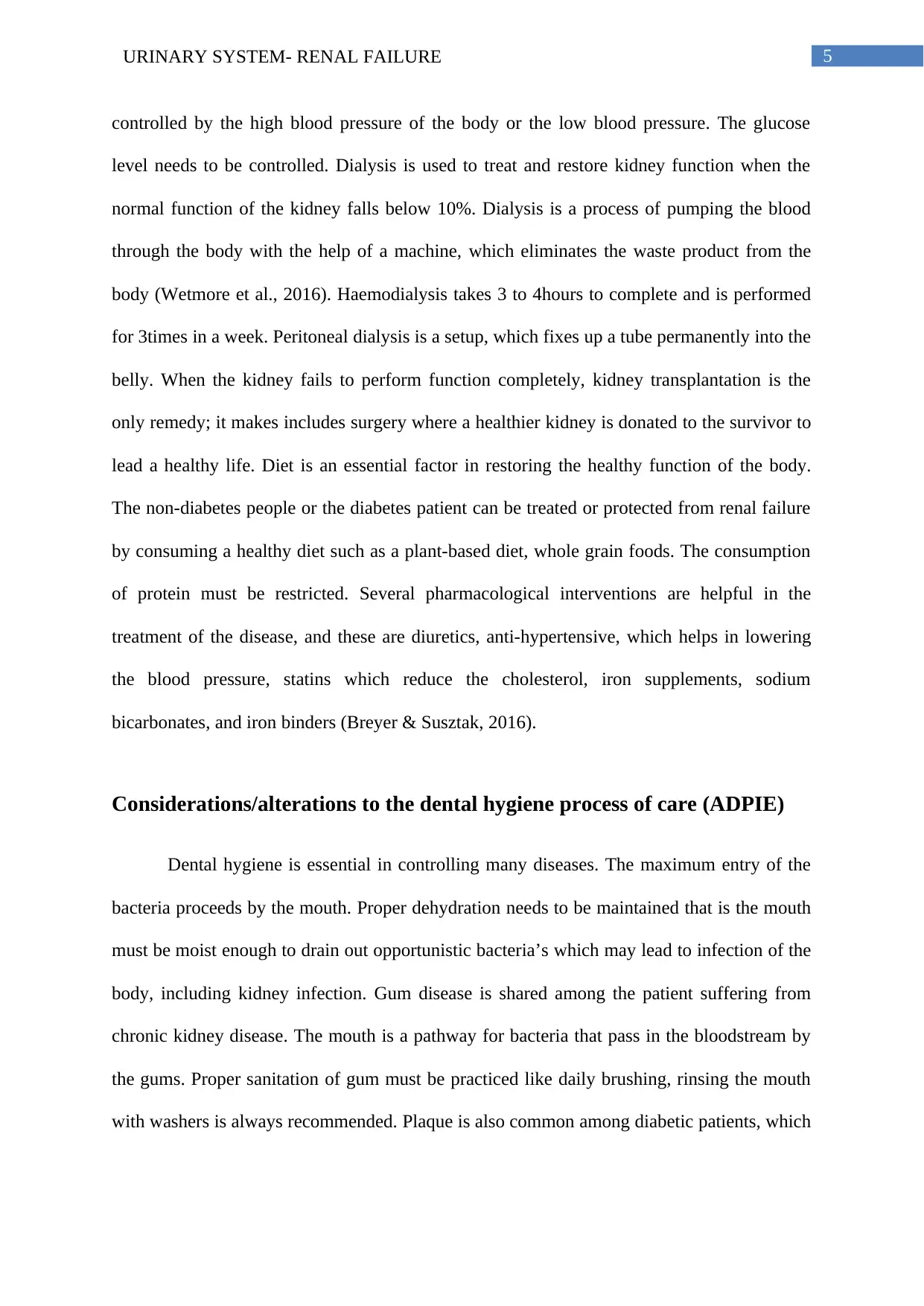
5URINARY SYSTEM- RENAL FAILURE
controlled by the high blood pressure of the body or the low blood pressure. The glucose
level needs to be controlled. Dialysis is used to treat and restore kidney function when the
normal function of the kidney falls below 10%. Dialysis is a process of pumping the blood
through the body with the help of a machine, which eliminates the waste product from the
body (Wetmore et al., 2016). Haemodialysis takes 3 to 4hours to complete and is performed
for 3times in a week. Peritoneal dialysis is a setup, which fixes up a tube permanently into the
belly. When the kidney fails to perform function completely, kidney transplantation is the
only remedy; it makes includes surgery where a healthier kidney is donated to the survivor to
lead a healthy life. Diet is an essential factor in restoring the healthy function of the body.
The non-diabetes people or the diabetes patient can be treated or protected from renal failure
by consuming a healthy diet such as a plant-based diet, whole grain foods. The consumption
of protein must be restricted. Several pharmacological interventions are helpful in the
treatment of the disease, and these are diuretics, anti-hypertensive, which helps in lowering
the blood pressure, statins which reduce the cholesterol, iron supplements, sodium
bicarbonates, and iron binders (Breyer & Susztak, 2016).
Considerations/alterations to the dental hygiene process of care (ADPIE)
Dental hygiene is essential in controlling many diseases. The maximum entry of the
bacteria proceeds by the mouth. Proper dehydration needs to be maintained that is the mouth
must be moist enough to drain out opportunistic bacteria’s which may lead to infection of the
body, including kidney infection. Gum disease is shared among the patient suffering from
chronic kidney disease. The mouth is a pathway for bacteria that pass in the bloodstream by
the gums. Proper sanitation of gum must be practiced like daily brushing, rinsing the mouth
with washers is always recommended. Plaque is also common among diabetic patients, which
controlled by the high blood pressure of the body or the low blood pressure. The glucose
level needs to be controlled. Dialysis is used to treat and restore kidney function when the
normal function of the kidney falls below 10%. Dialysis is a process of pumping the blood
through the body with the help of a machine, which eliminates the waste product from the
body (Wetmore et al., 2016). Haemodialysis takes 3 to 4hours to complete and is performed
for 3times in a week. Peritoneal dialysis is a setup, which fixes up a tube permanently into the
belly. When the kidney fails to perform function completely, kidney transplantation is the
only remedy; it makes includes surgery where a healthier kidney is donated to the survivor to
lead a healthy life. Diet is an essential factor in restoring the healthy function of the body.
The non-diabetes people or the diabetes patient can be treated or protected from renal failure
by consuming a healthy diet such as a plant-based diet, whole grain foods. The consumption
of protein must be restricted. Several pharmacological interventions are helpful in the
treatment of the disease, and these are diuretics, anti-hypertensive, which helps in lowering
the blood pressure, statins which reduce the cholesterol, iron supplements, sodium
bicarbonates, and iron binders (Breyer & Susztak, 2016).
Considerations/alterations to the dental hygiene process of care (ADPIE)
Dental hygiene is essential in controlling many diseases. The maximum entry of the
bacteria proceeds by the mouth. Proper dehydration needs to be maintained that is the mouth
must be moist enough to drain out opportunistic bacteria’s which may lead to infection of the
body, including kidney infection. Gum disease is shared among the patient suffering from
chronic kidney disease. The mouth is a pathway for bacteria that pass in the bloodstream by
the gums. Proper sanitation of gum must be practiced like daily brushing, rinsing the mouth
with washers is always recommended. Plaque is also common among diabetic patients, which
⊘ This is a preview!⊘
Do you want full access?
Subscribe today to unlock all pages.

Trusted by 1+ million students worldwide
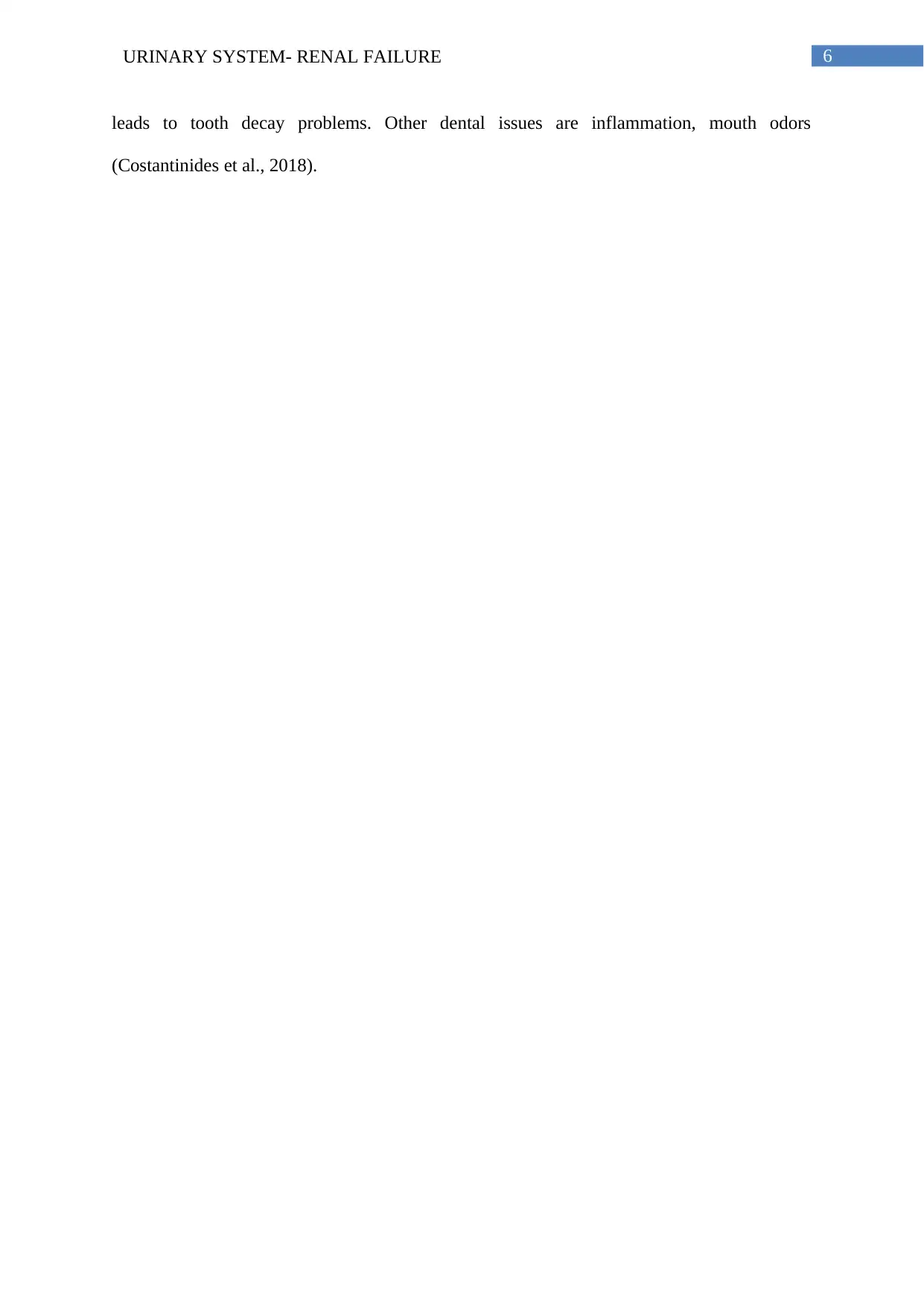
6URINARY SYSTEM- RENAL FAILURE
leads to tooth decay problems. Other dental issues are inflammation, mouth odors
(Costantinides et al., 2018).
leads to tooth decay problems. Other dental issues are inflammation, mouth odors
(Costantinides et al., 2018).
Paraphrase This Document
Need a fresh take? Get an instant paraphrase of this document with our AI Paraphraser
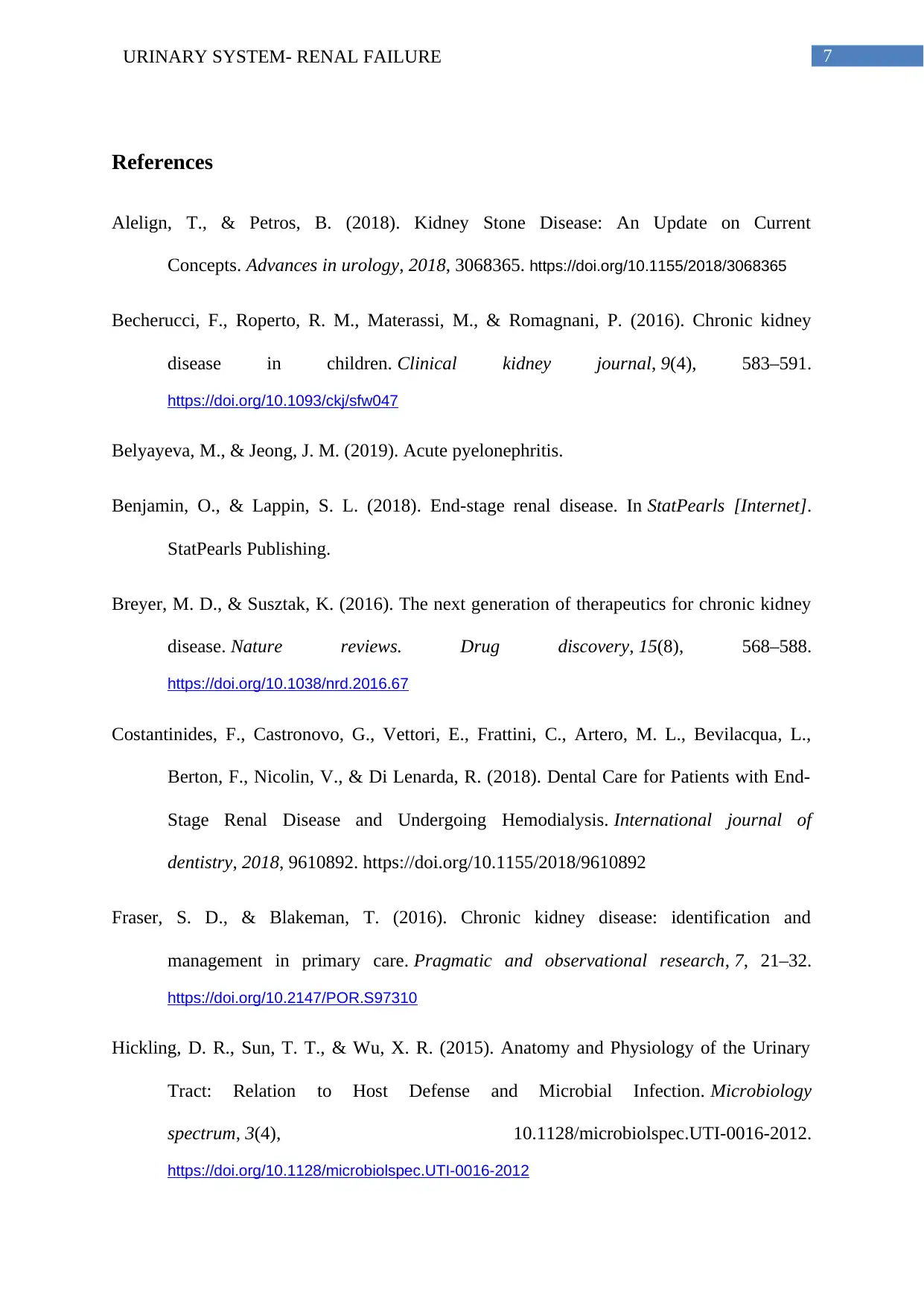
7URINARY SYSTEM- RENAL FAILURE
References
Alelign, T., & Petros, B. (2018). Kidney Stone Disease: An Update on Current
Concepts. Advances in urology, 2018, 3068365. https://doi.org/10.1155/2018/3068365
Becherucci, F., Roperto, R. M., Materassi, M., & Romagnani, P. (2016). Chronic kidney
disease in children. Clinical kidney journal, 9(4), 583–591.
https://doi.org/10.1093/ckj/sfw047
Belyayeva, M., & Jeong, J. M. (2019). Acute pyelonephritis.
Benjamin, O., & Lappin, S. L. (2018). End-stage renal disease. In StatPearls [Internet].
StatPearls Publishing.
Breyer, M. D., & Susztak, K. (2016). The next generation of therapeutics for chronic kidney
disease. Nature reviews. Drug discovery, 15(8), 568–588.
https://doi.org/10.1038/nrd.2016.67
Costantinides, F., Castronovo, G., Vettori, E., Frattini, C., Artero, M. L., Bevilacqua, L.,
Berton, F., Nicolin, V., & Di Lenarda, R. (2018). Dental Care for Patients with End-
Stage Renal Disease and Undergoing Hemodialysis. International journal of
dentistry, 2018, 9610892. https://doi.org/10.1155/2018/9610892
Fraser, S. D., & Blakeman, T. (2016). Chronic kidney disease: identification and
management in primary care. Pragmatic and observational research, 7, 21–32.
https://doi.org/10.2147/POR.S97310
Hickling, D. R., Sun, T. T., & Wu, X. R. (2015). Anatomy and Physiology of the Urinary
Tract: Relation to Host Defense and Microbial Infection. Microbiology
spectrum, 3(4), 10.1128/microbiolspec.UTI-0016-2012.
https://doi.org/10.1128/microbiolspec.UTI-0016-2012
References
Alelign, T., & Petros, B. (2018). Kidney Stone Disease: An Update on Current
Concepts. Advances in urology, 2018, 3068365. https://doi.org/10.1155/2018/3068365
Becherucci, F., Roperto, R. M., Materassi, M., & Romagnani, P. (2016). Chronic kidney
disease in children. Clinical kidney journal, 9(4), 583–591.
https://doi.org/10.1093/ckj/sfw047
Belyayeva, M., & Jeong, J. M. (2019). Acute pyelonephritis.
Benjamin, O., & Lappin, S. L. (2018). End-stage renal disease. In StatPearls [Internet].
StatPearls Publishing.
Breyer, M. D., & Susztak, K. (2016). The next generation of therapeutics for chronic kidney
disease. Nature reviews. Drug discovery, 15(8), 568–588.
https://doi.org/10.1038/nrd.2016.67
Costantinides, F., Castronovo, G., Vettori, E., Frattini, C., Artero, M. L., Bevilacqua, L.,
Berton, F., Nicolin, V., & Di Lenarda, R. (2018). Dental Care for Patients with End-
Stage Renal Disease and Undergoing Hemodialysis. International journal of
dentistry, 2018, 9610892. https://doi.org/10.1155/2018/9610892
Fraser, S. D., & Blakeman, T. (2016). Chronic kidney disease: identification and
management in primary care. Pragmatic and observational research, 7, 21–32.
https://doi.org/10.2147/POR.S97310
Hickling, D. R., Sun, T. T., & Wu, X. R. (2015). Anatomy and Physiology of the Urinary
Tract: Relation to Host Defense and Microbial Infection. Microbiology
spectrum, 3(4), 10.1128/microbiolspec.UTI-0016-2012.
https://doi.org/10.1128/microbiolspec.UTI-0016-2012
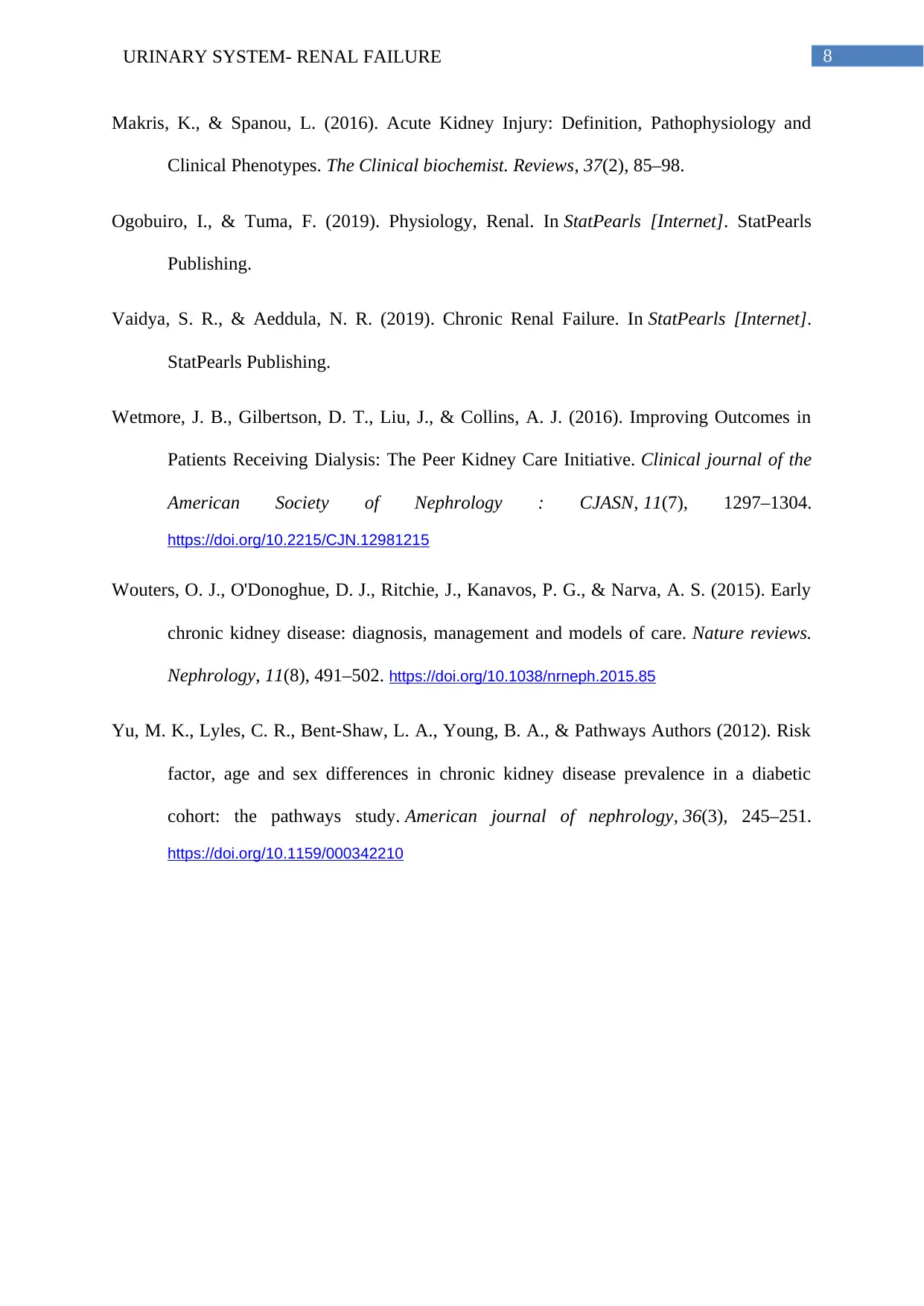
8URINARY SYSTEM- RENAL FAILURE
Makris, K., & Spanou, L. (2016). Acute Kidney Injury: Definition, Pathophysiology and
Clinical Phenotypes. The Clinical biochemist. Reviews, 37(2), 85–98.
Ogobuiro, I., & Tuma, F. (2019). Physiology, Renal. In StatPearls [Internet]. StatPearls
Publishing.
Vaidya, S. R., & Aeddula, N. R. (2019). Chronic Renal Failure. In StatPearls [Internet].
StatPearls Publishing.
Wetmore, J. B., Gilbertson, D. T., Liu, J., & Collins, A. J. (2016). Improving Outcomes in
Patients Receiving Dialysis: The Peer Kidney Care Initiative. Clinical journal of the
American Society of Nephrology : CJASN, 11(7), 1297–1304.
https://doi.org/10.2215/CJN.12981215
Wouters, O. J., O'Donoghue, D. J., Ritchie, J., Kanavos, P. G., & Narva, A. S. (2015). Early
chronic kidney disease: diagnosis, management and models of care. Nature reviews.
Nephrology, 11(8), 491–502. https://doi.org/10.1038/nrneph.2015.85
Yu, M. K., Lyles, C. R., Bent-Shaw, L. A., Young, B. A., & Pathways Authors (2012). Risk
factor, age and sex differences in chronic kidney disease prevalence in a diabetic
cohort: the pathways study. American journal of nephrology, 36(3), 245–251.
https://doi.org/10.1159/000342210
Makris, K., & Spanou, L. (2016). Acute Kidney Injury: Definition, Pathophysiology and
Clinical Phenotypes. The Clinical biochemist. Reviews, 37(2), 85–98.
Ogobuiro, I., & Tuma, F. (2019). Physiology, Renal. In StatPearls [Internet]. StatPearls
Publishing.
Vaidya, S. R., & Aeddula, N. R. (2019). Chronic Renal Failure. In StatPearls [Internet].
StatPearls Publishing.
Wetmore, J. B., Gilbertson, D. T., Liu, J., & Collins, A. J. (2016). Improving Outcomes in
Patients Receiving Dialysis: The Peer Kidney Care Initiative. Clinical journal of the
American Society of Nephrology : CJASN, 11(7), 1297–1304.
https://doi.org/10.2215/CJN.12981215
Wouters, O. J., O'Donoghue, D. J., Ritchie, J., Kanavos, P. G., & Narva, A. S. (2015). Early
chronic kidney disease: diagnosis, management and models of care. Nature reviews.
Nephrology, 11(8), 491–502. https://doi.org/10.1038/nrneph.2015.85
Yu, M. K., Lyles, C. R., Bent-Shaw, L. A., Young, B. A., & Pathways Authors (2012). Risk
factor, age and sex differences in chronic kidney disease prevalence in a diabetic
cohort: the pathways study. American journal of nephrology, 36(3), 245–251.
https://doi.org/10.1159/000342210
⊘ This is a preview!⊘
Do you want full access?
Subscribe today to unlock all pages.

Trusted by 1+ million students worldwide
1 out of 9
Related Documents
Your All-in-One AI-Powered Toolkit for Academic Success.
+13062052269
info@desklib.com
Available 24*7 on WhatsApp / Email
![[object Object]](/_next/static/media/star-bottom.7253800d.svg)
Unlock your academic potential
Copyright © 2020–2025 A2Z Services. All Rights Reserved. Developed and managed by ZUCOL.





